#restlessgifs
Photo








MY FAVORITE INSTANCES OF FORESHADOWING IN RESTLESS [ 1 / ? ]
Buffy, wearing overalls and pigtails, drags Giles through a fairground. Her mannerisms and outfit imply that this dream Buffy is much younger than her physical appearance would indicate. When Willow visits Buffy in her subconscious in 5.21 “The Weight of the World,” we see Buffy as a child once more, again wearing her hair in pigtails. In this supposed memory, her parents are bringing Dawn home from the hospital. Buffy asks her mom if she can be the one to look after her sister. Back in the dream, Olivia pushes an empty stroller beside Giles and Buffy. This stroller is likely for Buffy, considering that we’re meant to take her as being roughly the same age as in the later memory. However, as the episode repeatedly references Dawn’s arrival, it could also be taken as a placeholder where Dawn will eventually be filled in, the younger sibling getting pushed in the stroller. Therefore, this is demonstrating not only Dawn’s impending appearance, but the idea that she will be the same person as Buffy as well, given how the stroller represents Buffy’s childhood innocence and Dawn’s introduction to the show simultaneously. In this, they establish the nature of Buffy and Dawn’s relationship to each other on a metaphysical level, as well as Buffy’s role as a parental figure/caretaker for Dawn, and Dawn’s role as Buffy’s innocence and life force.
Buffy plays a carnival game where she throws balls at a cutout of a vampire. When she hits the vampire she turns around and looks excitedly at Giles, who tells her “I haven’t got any treats.” When Olivia tells him to go easy on Buffy, he responds, “This is my business. Blood of the lamb and all that.” This is relevant on several fronts. The lamb is symbolic of spring, innocence, renewal, and the power of life overcoming death. This gives it a direct connection to Dawn, who is named for the moment that night becomes day again, and is an equal symbol of renewal. The blood of the lamb, on the other hand, denotes sacrifice; in specific terms, it traditionally refers to the death of Christ on the cross. The line is a reference to how the Watcher’s Council sacrifices the lives of the young girls called as Slayers, that it is their “business.” However, blood is also what will eventually trigger the ritual in “The Gift.” The impetus of this ritual sees Giles attempt to convince Buffy that they may need to kill Dawn in order to save the world. Buffy is able to sacrifice herself in Dawn’s place because she shares Dawn’s blood. The purpose of her sacrifice is to fulfill her duty as Dawn’s caretaker and preserve Dawn as is her innocence and life force, roles which have been previously established. Therefore, this line foreshadows all three of the these characters’ positions in the closing of the fifth season. Dawn will be sacrificed by a god. Giles will be willing to sacrifice Dawn, and therefore Buffy, for the greater good. Buffy will martyr herself to save Dawn. All of this is linked by the themes of blood and sacrifice. The connection to the lamb, Dawn, and Christ, as symbols of renewal, foreshadows Buffy’s death, as well as her eventual resurrection.
Around this point Spike appears in the dream and calls Giles into his crypt, which sits at the edge of the fairgrounds. The position of the crypt within the dream is symbolic of the fringes of the consciousness, the same place that the Jungian shadow theoretically exists. As Giles walks in, we see Olivia sitting next to the stroller, now overturned, and sobbing. If the stroller represents both Dawn and Buffy, then this overturned stroller would represent Buffy’s ‘giving up,’ both when she loses Dawn at the end of 5.20 “Spiral,” and in the moment she tells Willow about in “The Weight of the World.” She explains to Willow that she feels this moment of weakness means that she’s killed Dawn, which further links her to Olivia and the stroller, as both an extension of Dawn, and her ‘failure’ as Dawn’s caregiver. The child form of Buffy is now absent from the dream, while Buffy’s season five self becomes locked within her subconscious. Dream Buffy’s disappearance comes after she smears her face in mud, and at the same time Giles enters Spike’s crypt; mud being representative of the primordial beginnings of life, and Spike being representative of Buffy’s subconscious. Her fear that “death is [her] gift,” as the First Slayer, the orchestrator of this dream, eventually tells her, and that she will inevitably kill Dawn, which brings on her catatonia, is again linked to Spike as a representation of the shadow, that which Buffy fears and rejects about herself. This creates even more of a connection between the landscape of the dream and the events of the following season. Additionally, it strengthens the link between Spike and Buffy’s preordained death, as the phrase “death is your gift” is repeated once more before Buffy jumps, and, in actuality, refers to her death as an act of heroism and martyrdom. It’s also notable that in the same episode where Buffy becomes catatonic after losing Dawn, “Spiral,” Dawn, Spike, and Giles, the central figures in this dream sequence, are given stigmata. Spike cuts both his hands, Dawn has a wound on her temple, and Giles’ side is pierced with a spear. In this, the biblical imagery, specifically concerning the crucifixion as a signal of Buffy’s imminent death, is furthered.
While in the crypt we see the scene in color when the frame focuses on Giles, and in black and white when it focuses on Spike. That Spike can be seen only through the lens of light and shadow conjures the nature of his relationship with Buffy, more precisely, his role as her shadow. This establishes him as representative of her within the scene (again, it is notable that she disappears the moment that he appears). He tells Giles that he’s “hired himself out as an attraction,” and when Giles asks if it’s as a “sideshow freak,” he answers “at least it’s showbiz.” Before Giles leaves he tells Spike that he “still thinks Buffy should have killed [him].” Spike responds by giving an annoyed look and then striking a Jesus on the cross pose for the photographers. This is the same pose that Buffy assumes when she jumps from the tower, the flashing of cameras mimicking the flashing lights of the portal. Giles’ assertion that Buffy should kill Spike reveals that she will be the one to end her own life, literally killing her “self.” In this they foreshadow not only Buffy’s death and resurrection, but it’s pageantry as well. Her body takes the same symbolic position of martyrdom as she falls that Spike does for “showbiz.” Buffy dies to save the world as an affront to a god, not in service of one, and when she’s later resurrected the world is no better than when she left it. The reward for her grand sacrifice is to live with the tediousness and injustice of reality. Thus, this particular sequence illustrates the end of the fifth season, as well as the sixth season’s rejection of both the martyr and the grandiose, cinematic ending. As much as Buffy will save the world through her death, the gravitas of her martyrdom is nothing but a glossy illusion covering the brutal truth of the situation. Essentially, that it will be a subversion of television and film’s tendency to ignore the repercussions of reality because the fantasy is simpler and more impressive.
#btvsedit#btvs meta#dailybuffysummers#spuffygifs#buffysource#userbbelcher#cinemapix#chewieblog#throwbackblr#tvandfilm#fantasysource#tuserveronika#useralexa#usercande#gif#restlessgifs#meta#i know this is kind of a weird gif series idea#but restless is one of my very favorite episodes#and i feel like i always see people talking about the same few examples of foreshadowing in it#(if they don't just call it stupid and pointless)#and a lot of the foreshadowing that i think is really brilliant i never see acknowledged#so here we are lkadsjkfl#justice for restless#i'm not sure how much i should include because there's a lot of great symbolism that isn't necessarily foreshadowing#because ultimately it's all about the subconscious#so it's in equal turns looking backwards and looking forwards#the archetypes and their manifestation in the individual#but i don't want to go in on jung too much bc i feel like i'll lose people but it's hard it's like the core of this show dlkfjaksl#all that to say this isn't my clearest writing so feel free to ask for clarification 😭
478 notes
·
View notes
Photo
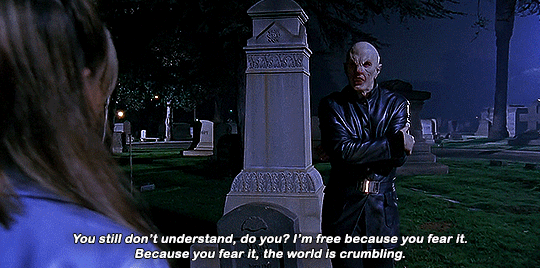


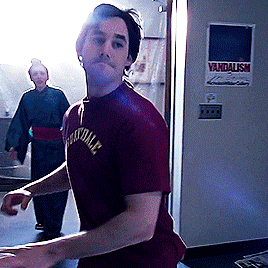


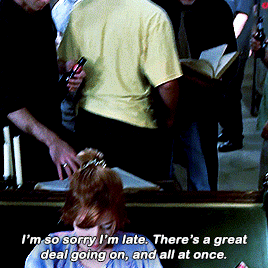

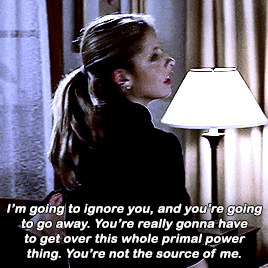
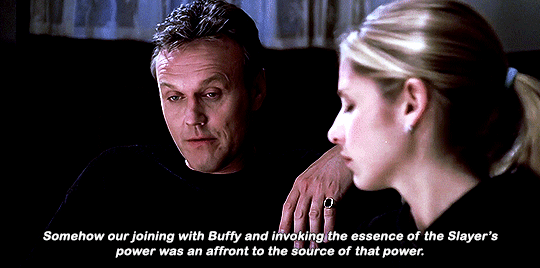
MY FAVORITE INSTANCES OF FORESHADOWING IN RESTLESS [ 2 / ? ]
So, clearly, these are not instances of foreshadowing; they’re callbacks to previous scenes. However, before I get any further into this series I wanted to address “Restless’” counterpart, the season one episode, “Nightmares.” Dreams are the primary vehicle that the unconscious uses to communicate with the conscious mind, and the universal association between dreams and the unconscious makes the nature of the unconscious especially important in these particular episodes. Billy literally becomes unconscious, causing everyone’s repressed fears to come into the realm of consciousness. “Nightmares” has a very specific focus on fear and repression. As the Master says, “I’m free because you fear it.” It is about the shadow. The Master escapes his underground prison (the unconscious) and rises to the surface (consciousness). If you can confront your fears and acknowledge them they cease to threaten or control you. This is why it’s meaningful that the motifs established in “Nightmares” reoccur in “Restless.” “Restless” is not about the shadow, at least, not exclusively about the shadow in the way that “Nightmares” is. It has a much wider scope and pulls from something Jung calls the “supraordinate personality” or “mana-personality” which is a symbol of the Self, the opposites, conscious and unconscious, united as a whole. It is not about the conflict between shadow and ego, but unity between the two. It is also notably not exclusively about repression. Repressed thought contents were, by definition, once conscious, and heavily linked to the shadow archetype in particular. However, the supraordinate personality encompasses these contents, as well as the consciousness, and psychic contents which have never been conscious and are completely inaccessible to the conscious mind. I will go into the details of each of these parallels in more depth in separate posts, but before I do that I want to establish the significance of “Nightmares” in the context of “Restless,” and by extension, the function of “Restless” as a whole.
In both episodes Willow displays a fear of performance. In “Nightmares” she is forced out on stage at an opera, unprepared. In “Restless” she she shows up to drama class, but once again she’s unprepared and doesn’t know her lines. She then has to give a report in a high school classroom while everyone snickers or acts bored. Tara tells her “They will find out you know. About you.” All of this relates to the “persona.” Named for the mask worn by actors to demonstrate their role, Jungian psychology defines the persona as the “mask” each person presents to the world. It is the construction we create of ourselves, bringing forward traits that we feel portray us as more attractive and favorable and repressing traits that we find undesirable or shameful. The persona is, by definition, false. It is literally a performance. “Spiritius,” or “spirit,” as Willow is labeled in “Primeval,” the episode preceding “Restless,” in Jungian terms is an almost elemental force with power and knowledge exceeding that of a human’s. However, the idea of spirit, even outside of Jungian psychology, is linked to the anima, which, like the shadow, has a compensatory relationship with the persona; all the qualities which are hidden from the outside world are found in these archetypes. Therefore, Willow’s continuous inability to take up the role assigned to her indicates a persistent disharmony between the inner self and the outer one, a fear that one will be outed as an actor, and even a worse, an actor who doesn’t know her lines. In terms of foreshadowing this alludes to the eventual disintegration of the persona in Buffy, an essential part of the individuation process where the mask is destroyed and the true self is revealed.
Where Xander conquers his fear in “Nightmares,” he fully succumbs to it in “Restless.” In the former episode he begins to run from the clown before changing his mind, turning around, and decking it. If the episode is about unconscious fears then this action is both an acknowledgement of the fear and the domination of it. In “Primeval” Xander is described as the “animus” or “heart.” The function of the anima/animus is Jungian psychology is vastly complex but in this instance it’s probably most notable that the word anima/animus means, among other things, “soul.” Xander’s confronting the clown in “Nightmares” is a show of heart, soul, or spirit. It shows that the soul hasn’t been overtaken by the shadow. Conversely, in “Restless” he stands paralyzed in fear as his father rips his heart out. The heart losing his heart would therefore be comparable to the soul losing its soul. In Jungian terms, “loss of soul” (not to be confused with any in-universe soul lore) occurs when the ego (the conscious realm of the psyche) identifies with the “mana-personality,” the godlike figure representing the whole of the Self, as we will see occur later in Buffy’s dream. Many times this form is represented by the hero archetype. This identification results in ego-inflation, where the ego dominates the psyche, and as a result unconscious contents begin to seep into the consciousness without being differentiated, influencing of the actions of the individual without their being aware of it. This, too, marks a critical point in the individuation process, as negative inflation signals the potential integration of the unconscious and conscious; for this to happen identification must shift from the ego to the Self.
In “Nightmares” Giles becomes lost in the library and loses his ability to read. In “Restless” he shows up “late” to where Xander and Willow are reading and presumably researching something at ‘the Bronze,’ explaining that it’s because there’s so much happening. All of these things correspond to his role in “Primeval” as “sophus” or “mind.” It also draws a strong connection to the paternal principle of Logos, which defines the conscious mind. Therefore, Giles’ continual struggle to read and tendency to get lost or be late demonstrates the weakening of consciousness. In “Nightmares,” the point of this is obvious; dreams and reality are merging and the conscious mind is losing its dominance over the unconscious. However, the reoccurrence of these themes in “Restless” has a different implication, because dreams and reality are not merging. It is still only a dream, and given that this episode has such an air of prophecy, it indicates not just a weakening of the mind in the present, but in the future as well. Just as with Willow’s relationship to the persona, what in “Nightmares” was a manifestation of the shadow dominating the conscious realm, here signifies something vastly more complex. Because the conscious has repeatedly ignored and rejected the unconscious, it is beginning to lose its foothold. As I explained in the first post of this series, this too is related to Buffy’s impending death, the regression which proceeds rebirth, an essential part of the hero cycle and therefore the individuation process.
While Giles and Willow’s sequences and themes remain more or less consistent, Xander’s is completely inverted. That both his and Buffy’s sequences deal more directly with the confrontation of the unconscious implies that Buffy’s sequence is inverted as well. Just as Xander is able to overcome his fear in “Nightmares,” Buffy is able to embody her shadow, if only temporarily. However, in Restless she ends up rejecting not just the shadow, but the entire Self. Willow’s, Xander’s, and Giles’ dream sequences all indicate some kind of rift or discordance between aspects of the psyche, particularly conscious and unconscious, implying that Buffy too is facing a divide between the ego-conscious and the unconscious psyche. On the surface, her rejection of the First Slayer, her insistence that she is different and that she is not alone, appears to be a triumph, like her confrontation with the monster in “Nightmares,” but that is only true if you are taking the First Slayer’s appearance as a threat. This is the fundamental misunderstanding that defines the episode. All of this is relevant because to really understand foreshadowing in “Restless” we have to understand why it’s there in the first place.
“The transformation processes strive to approximate them to one another, but our consciousness is aware of resistances, because the other person seems strange and uncanny, and because we cannot get accustomed to the idea that we are not absolute master in our own house. We should prefer to be always ‘I’ and nothing else. But we are confronted by that inner friend or foe, and whether he is our friend or foe depends on ourselves.” – C.G. Jung (“Concerning Rebirth,” CW 9, para. 235)
At no point does the First Slayer actually threaten Buffy. In the very next season she tells Buffy that she is full of love, that the Slayer takes her power from love, and that she is at risk of losing it because she continues to push it away. Considering this, it makes no sense for her to now be telling Buffy that she has to be alone to be a good Slayer, or that she needs to get rid of her friends. As Giles says in the final gif, she was brought forth because they joined together. Four is a number which represents unity and individuation, as it reflects the quaternity, a fundamental symbol of the Self. As Jung states in the above quotation, the supraordinate personality, which he here calls “the inner friend of the soul,” may at first seem threatening or uncanny and the conscious mind may resist it for this reason. The idea that “we cannot get accustomed to the idea that we are not absolute master in our own house,” perfectly reflects Buffy telling the First Slayer that, “you’re not the source of me.” This does not actually mean the First Slayer is an enemy. She very notably speaks to Buffy in the present tense, never future. These are not threats; they are facts. When Buffy asks where her friends are she responds, “you’re asking the wrong questions.” She tells Buffy “No friends, just the kill,” but there is nothing to actually say that this is an instruction or a demand. In the very next episode Buffy leaves her boyfriend in bed to go hunt vampires. I don’t think it’s unreasonable, then, to assume that she is simply informing Buffy that this is how things are right now, and will be the direction that they continue to lead if Buffy doesn’t acknowledge them. When she tells Buffy “the Slayer does not walk in this world,” Buffy takes this to mean that she does not walk in this world, which is exactly the problem. She, the ego, has identified herself with the Self, the divine figure or hero, when in just the last episode we saw that Buffy is clearly only one part of this force. She is the hand, the one that power flows through, but she is still only one part of four, not the whole. The First Slayer tells her “We are alone!” not “We must be alone” or “We should be alone.” They are alone, right now, in this moment. Her usage of the word “we” is similarly consistent with the idea of the supraordinate personality. Were this just about her and Buffy there’s no reason that others would have to be involved in the dream. They were involved because they participated in the ritual and the ritual was about all of them making up a whole, all elements of the personality combined accessing a transcendent, inhuman, and elemental force: the Self. All of them together called the First Slayer forward and so when she says “We are alone,” she refers to all of them. Each of them is isolated. The personality is splintered. This is what she is trying to communicate to Buffy.
While “Nightmares” signals the struggle of the conscious to rise above the unconscious (note Buffy literally walking from the darkness into the light in the 8th gif), a positive process, “Restless” portrays a rejection of the unconscious wholesale. This rejection is a distinctly negative action and explicitly dangerous because when one rejects or dismisses the unconscious they leave themselves vulnerable to its influence (Buffy retreats from the blinding light of the desert to the darkness of her living room). Giles and Willow indicate the weakening of the conscious mind, but where Xander and Buffy signify the momentary victory over the unconscious in “Nightmares,” the inversion of their scenes in “Restless” indicates the opposite. The unconscious is winning. If we are to assume that the First Slayer is the orchestrator of this dream, that she is the one who is showing us, in her own words, “what’s to come,” and if we are assuming that she is trying to tell Buffy that her psyche is fragmented, then I think we can take this foreshadowing as not a threat, but a warning. This is what will happen if Buffy doesn’t listen. Of course, Buffy doesn’t listen, and so we see everything that we were warned against come to pass. Still, the arrival of the First Slayer, the supraordinate personality, is an indication of the progression of the individuation process. If Buffy can differentiate herself, her ego, from the Slayer identity (the hero archetype), then all hope is not yet lost. Therefore the parallels with “Nightmares” indicate a necessary regression. Buffy’s impending struggle with depression, what Jung would call “loss of soul,” is foreshadowed as a sign of future development, of light overcoming dark once again: death and rebirth.
#btvsedit#btvs#btvs meta#dailybuffysummers#spuffygifs#buffysource#userbbelcher#userveronika#useralexa#usercande#chewieblog#cinemapix#filmtv#horroredit#tvedit#gif#restlessgifs#meta#i am so sorry this is such an awful explanation#like i said i'll get more into the specifics of each in separate posts but i needed to establish the connection#between the two episodes first#turns out gif sets aren't the best format for literary analysis#who knew#and as always sorry for typos or grammar errors my brain doesn't work right#and sorry too for all the jung stuff hopefully it's still somewhat comprehensible anyways
344 notes
·
View notes